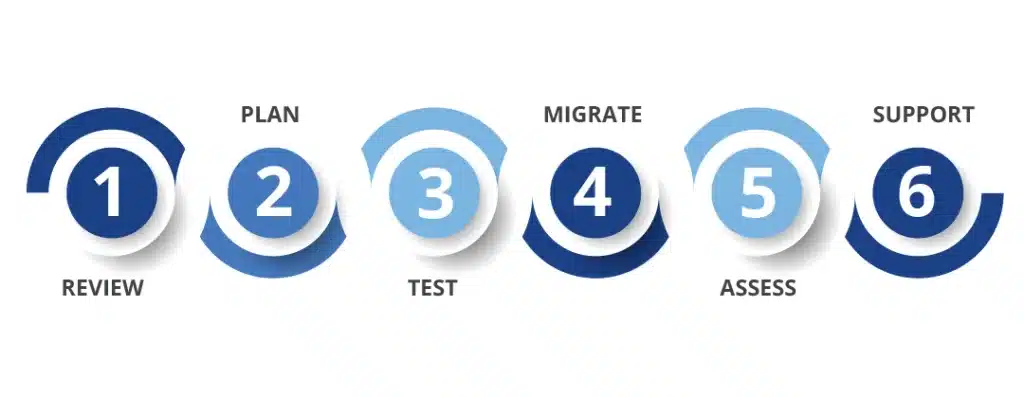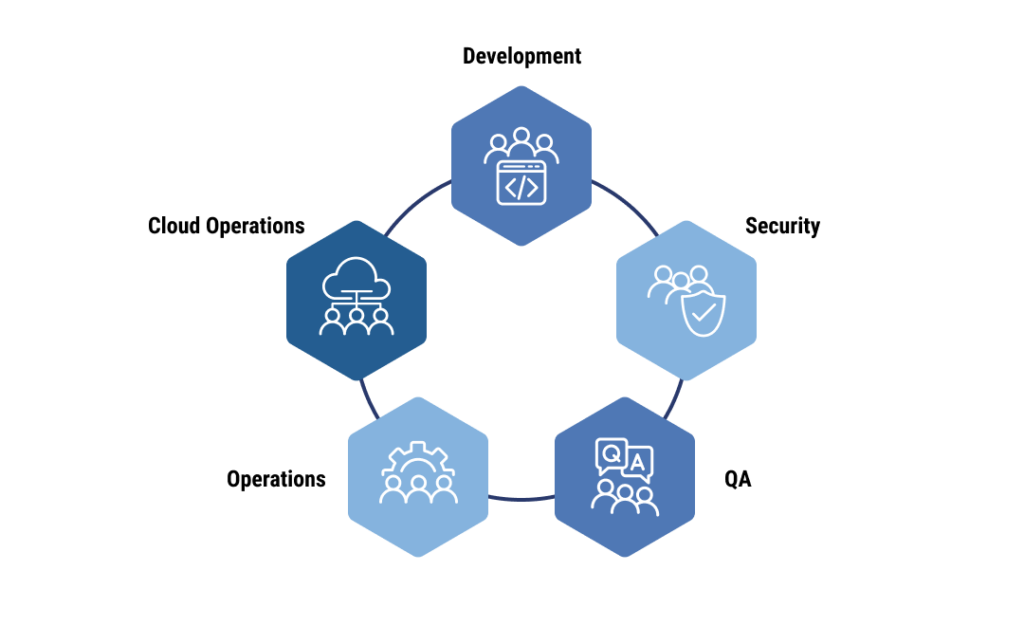July 19, 2023 | Channing Lovett
Key Considerations to an Effective DevOps Migration Strategy

As organizations continue to embrace cloud computing and incorporate DevOps practices into their plans, forming an effective DevOps migration strategy is not just a nice-to-have for digital transformation, it’s a critical need. Migrating requires careful planning and consideration of numerous factors to ensure a seamless transition while maximizing the benefits of cloud DevOps methodologies.
In this article, we’ll explore principles of a DevOps migration strategy, key considerations, and best practices when developing an effective DevOps migration strategy.
An Overview of the Cloud DevOps Model
In a cloud DevOps model, development and operations teams collaborate closely throughout the software development lifecycle, including the design, development, testing, deployment, and support phases. This collaborative approach improves the efficiency of delivering applications and services. How? It breaks down silos and promotes shared responsibilities.
To further align operations with development practices, operations teams may adopt techniques commonly used by developers. For example, they may embrace the Agile development process, which emphasizes iterative and incremental development, close collaboration, and frequent feedback. By adopting Agile principles, operations teams can adapt to changing requirements and deliver value more rapidly.
What is a DevOps Migration Strategy?
A DevOps migration strategy is a detailed plan and approach used by an organization when transitioning its applications and infrastructure to a DevOps environment. Although a DevOps environment mainly involves a change in organization structure (rather than physical infrastructure), it can be completed alongside a cloud migration, which enables organizations to take advantage of the benefits offered by cloud platforms.
When a business decides to shift to a DevOps configuration, a well-defined migration strategy becomes essential and helps determine necessary considerations for successful organization restructuring. It involves identifying and reviewing the roles and responsibilities of team members involved, defining the new workflows and processes, assessing the tools and technologies that may need to be incorporated or updated, and establishing metrics to measure the success of the migration.

A cloud DevOps migration strategy needs to use best practices and cover several key aspects:
- Outline the desired state of the DevOps environment
- Acknowledge the specific goals the organization wants to achieve
- Provide a roadmap for the phased implementation of DevOps practices, considering factors such as project priorities, resource availability, and potential risks
- Address the integration of cloud services and infrastructure into the DevOps environment, which may include cloud-native tool adoption, configuring cloud resources to support automation and scalability, etc.
Additionally, effective communication and collaboration between teams are crucial during the migration process. To ensure the successful adoption of DevOps practices, the strategy should also include plans for fostering:
- Cross-functional collaboration
- Knowledge sharing
- Training initiatives
Another important aspect of DevOps migration is the increased focus on testing. Operations teams may start testing more frequently and early in the development process to identify and address issues proactively. This shift towards continuous testing helps ensure the quality, reliability, and performance of applications and reduces the likelihood of encountering problems in production.
Why is a DevOps Migration Strategy Important?
As IT systems become more complex, migrating to a DevOps configuration can help organizations find simplicity and efficiency . The cloud DevOps model offers a solution by streamlining processes and fostering collboration between teams within the organization. The more you’re able to collaborate and integrate teams using DevOps principles, the more improvements you can see.
For example, by encouraging cross-functional collaboration and knowledge sharing, companies can unlock synergies and leverage diverse expertise. This integration leads to smoother handoffs, faster issue resolution, and a shared sense of ownership, ultimately resulting in high-quality deliverables.
Principles of a DevOps Migration Strategy
Evaluate IT Infrastructure and Tools
To lay the proper groundwork, an organization should begin its DevOps migration strategy by identifying goals that align with where they want its development projects to go. The DevOps team can use these goals to evaluate their infrastructure and determine if they have the tools and framework they need to get to where they want to be. The strategy should include a plan for how to phase out less-than-helpful tools, as well as a list of priorities and desired features that can help choose new tools.
If some tools have been working fine, but could stand to be changed in the name of efficiency, integration, or cost-saving, include those notes in the evaluation as well. This can also help determine what gets migrated now versus later, or what gets migrated at all. Businesses should also consider the time it takes to migrate workloads over and the potential disruption a move will have on business.
Traditional IT vs. DevOps
Traditional IT is generally more specialized and siloed. For example, it’s uncommon to have the operations team interact with the development team. IT teams may also have divisions in labor between compute, networking, and storage tasks. Because of this segmentation, it can be difficult to coordinate larger tasks, leading to delays in provisioning.
In contrast, DevOps merges the development and operations teams to form a cohesive unit. The team then works together to achieve a unified outcome through shared processes and automation.
Automation Tools
By leveraging automation tools and practices, businesses can achieve faster and more reliable deployments, saving time and effort while ensuring consistency across environments. Which tools make sense will depend on how your business is currently structured and which processes can be replicated using automated rules.
Tools commonly used in cloud DevOps include:
- Continuous Integration or Continuous Deliver: These automate the build, testing, and deployment processes. They also allow developers to frequently integrate code changes and automatically build, test, and launch applications in different environments.
- Configuration Management: Such tools assist in automating the provisioning and management of infrastructure and system configurations.
- Infrastructure as Code: IaC tools enable the provisioning and management of cloud resources and infrastructure using code; and they enable infrastructure to be defined, versioned, and deployed programmatically.
- Testing and Test Automation: A critical element in the DevOps model is testing to detect issues early on in the development process and ensure quality. Testing tools can be used to automate various types of testing, including unit, integration, and end-to-end.
- Containerization: Containers provide a consistent, isolated environment for apps to operate across different systems. These tools allow for the creation, deployment, and management of containerized applications.
- Monitoring and Logging: Monitoring and logging tools can be used to track the performance, availability, and health of applications and infrastructure while also providing real-time visibility into elements such as system metrics, logs, and events.
- Collaboration and Communication: These tools enable effective communication and coordination between different teams within an organization, and allow code, documentation, and insights to be securely shared.
High-Performing IT
The continuous delivery approach strengthens the feedback loop between development and operations teams. This leads to faster identification and resolution of issues, thus allowing teams to identify and resolve defects earlier in the development process which improves the overall quality and stability of the software.
The frequent deployment characteristic of cloud DevOps models contribute to decreased failure rates and improved recovery times. “High-performing” IT companies who adopt a mindset that encourages risk-taking and experimentations, are more adept at discovering and addressing issues rapidly. If a failure or an incident occurs, the streamlined deployment processes and automated infrastructure provisioning enable swift recovery, as well as rollback, minimizing the impact on users and the business.
All in all, the cloud DevOps model not only results in lower failure rates and shorter recovery times, but also enhances an organization’s ability to:
- Quickly deliver value to users
- Stay ahead of market demands
- Drive innovation
DevOps Requires Teamwork

Of course, anything that calls for the formation of a team also requires collaboration to be successful. This can mean making large cultural shifts and setting new organizational expectations. Consider the following questions:
- What are common goals everyone can get around? Common goals should align with overall business objectives such as enhancing customer satisfaction, improving time-to-market, or increasing operational efficiency. By establishing shared objectives, the team can work together towards a unified vision.
- How will responsibilities be assigned and what does the management structure look like? Determining the management structure is another critical aspect of team collaboration. Embracing agile and lean management principles can empower teams to make decisions, take ownership, and self-organize, leading to increased collaboration and efficiency.
- How will success be evaluated? Key performance indicators (KPIs) may include deployment frequency, lead time for changes, mean time to recovery, customer satisfaction, and business impact. Regularly reviewing and assessing these metrics enables the team to monitor progress, identify areas for improvement, and celebrate achievements.
The important thing to remember is that you can start small. Building the foundation and determining what will be automated, how testing will be carried out, and what goals the team shares, will pave the way to a more effective DevOps team.
What to Consider in Your DevOps Migration Strategy?
DevOps migration is an ongoing process that requires commitment, continuous improvement, and a willingness to embrace change. It requires teams to adopt new mindsets, embrace automation, and leverage shared tools and processes to streamline the software development and delivery lifecycle.
When you’re migrating your teams to a DevOps model, you’ll want to consider the following:
Selecting the Right Tools & Technology
Just because a DevOps tool is popular doesn’t mean it’s appropriate for your team and your specific requirements . You’ll want to consider the learning curve necessary to master the tool, how it integrates with the rest of your tech stack, how well it can scale, the availability of documentation, its security features, and more. Some popular tools for configuration management are Ansible, Chef, CFEngine, and Puppet, but to make the right choice for your team, you’ll have to conduct a careful evaluation.
Planning Infrastructure Changes
As organizations embrace DevOps practices, they may find that their existing infrastructure needs to be reconfigured or optimized to support the new workflows and requirements. This could involve scaling up or down resources, modifying network architectures, implementing automated provisioning and scaling mechanisms, adopting cloud-native technologies, or moving legacy application to a new cloud environment altogether.
Infrastructure changes may require collaboration with a data center provider or help from other managed service providers to ensure there is no dip in uptime and service.
DevOps Security (DevSecOps)
Microservices and containers used in DevOps, as well as other services and apps, can be vulnerable to security breaches if not properly managed and secured. However, when implemented with the appropriate security measures, they actually enahnce the security posture of DevOps environments.
A DevSecOps model places security at the center of DevOps processes, ensuring that it doesn’t become forgotten. The security team should work alongside developers, testers, and operations teams in a way that security becomes less of an event and more of an iterative, ongoing activity. This includes ensuring secure configurations for cloud resources, integrating security practices into development and deployment pipelines, implementing identity and access management controls, and leveraging encryption and monitoring solutions to protect data and applications.
An increase in security breach incidents, coinciding with stricter regulatory standards, has transformed DevSecOps from optional to practically mandatory.
Security is Shared Responsibility
As part of this integrative model, all parties are responsible for security, not just in a DevOps team, but across the entire organization. IT teams need to train employees to spot common security threats, security teams need to implement protocols, and development teams need to keep security in mind as they write code.
Automation
DevOps and automation often go hand-in-hand. An organization that’s looking to make its processes more efficient via DevOps should also understand the agility and improved accuracy that comes with automation. Implementing automation also reduces the amount of boring, repetitive tasks team members have to take on, allowing them to focus on more meaningful work that drives the business forward.
Continuous Integration and Continuous Delivery
In continuous integration and continuous delivery (CI/CD) environment, applications are always ready to deploy changes as the need arises. The only way this can be accomplished effectively is by automating certain processes that smooth out the development pipeline.
Small Code, Big Impact
Sometimes it’s the smallest pieces of code that have the biggest impacts on your business. This is often the case with automation. Creating small solutions that speed up a repetitive problem by even seconds can accumulate quickly into hours saved per week or more. The DevOps team should be considering what small changes can make these big impacts, and the Ops side can lend a lot of insight in this area.
Network Monitoring
By monitoring a network, businesses can find and troubleshoot problems regarding network traffic, applications, and devices. If there are performance bottlenecks or security threats, they can be found through network monitoring. A DevOps environment should have application, configuration, and cloud monitoring as part of what they’re observing in a network.
Application Monitoring
If users encounter a problem with an application, it may cause a loss of trust, decrease in engagement, or it may even get them to switch to another business. Mission-critical applications need reliable uptime, and they need to be free of bugs. Application monitoring can identify problems before they become detrimental to your business.
Configuration Monitoring
The way a network is configured can impact compliance, performance, and security. These settings mainly impact internal users, which means problems can hamper productivity or connectivity with customers and other end users. Configuration management should also be set up so that when changes are made, companies can revert back to previous configurations if something goes wrong.
Cloud Monitoring
Without proper monitoring, the use of cloud resources can get out of control. Organizations should be in the practice of tracking resource usage, managing budgets, and setting up automated rules to keep usage, and therefore costs, under control.
How TierPoint Can Help Accelerate Your DevOps Practice
A strong DevOps practice requires collaboration, communication, and a clear path forward. TierPoint offers consulting to help businesses form a strong DevOps practice, as well as define a DevOps implementation roadmap.
Need help with your DevOps practice? Learn more about our DevOps consulting services.
